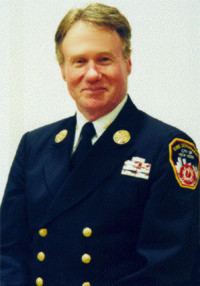Nationality United States Name Vincent Dunn | Role Author | |
 | ||
Residence New York City, New York, United States Books Collapse of burning buildings, Safety and survival on the firegr, Strategy of Firefighting, Command and Control of, The Vincent Dunn Vid | ||
Ufa training vincent dunn flashover
Vincent Joseph Dunn, born May 12, 1935 in Queens, New York, was a firefighter in New York City for 42 years, rising in rank to Commander of Division 3 (Midtown Manhattan). A contributing editor to Firehouse Magazine, he is the author of four books on firefighting. Two were written prior to his 1999 retirement from New York City Fire Department: 1988 - "Collapse of Burning Buildings: A Guide to Fireground Safety"; 1992 - "Safety and Survival on the Fireground". Two were written after retirement: 2000 - "Command and Control of Fires and Emergencies"; 2007 - "Strategy of Firefighting".
Contents
Dunn is a nationally recognized expert on high-rise firefighting, rescue, and building collapse. The National Institute of Standards and Technology (NIST), an agency within the United States Department of Commerce, selected him to serve as a consultant in its investigation into the collapse of the World Trade Center's Twin Towers and 7 World Trade Center.
In the Early 1980's Chief Dunn was an adjunct professor in the mechanical engineering department of Manhattan College in the Bronx, New York; instructing a course entitled "Fire Engineering". The course taught engineering students importance of fire loading design on concrete and fire resistant buildings, and how it related to structural integraty and building survivability.
Dunn wrote in his August 2000 newsletter, "The best-kept secret in America's fire service is that firefighters cannot extinguish a fire in a 20- or 30-thousand-square-foot open floor area in a high-rise building. A fire company advancing a 2½-inch hoseline with a 1¼-inch nozzle discharges only 300 gallons per minute and can extinguish only about 2,500 square feet of fire. The reach of the streams is only 50 feet. A modern open-floor office design, with cubicle work stations and dwarf partitions that do not extend to the ceiling, allows fire to spread throughout an entire 100- × 200-foot floor area. A fully involved, free burning 20,000-square-foot floor area cannot be extinguished by a couple of firefighters spraying a hose stream from a stairway. City managers and department chiefs will not admit this to the public if they want to keep their jobs. But every fireground commander knows this is a fact."
In the January 1, 2002, issue of Fire Engineering, an article co-written by Dunn regarding the collapse of the three World Trade Center towers stated, "Now, with that understanding, you would think we would have the largest fire investigation in world history. You would be wrong. Instead, we have a series of unconnected and uncoordinated superficial inquiries. No comprehensive 'Presidential Blue Ribbon Commission'. No top-notch National Transportation Safety Board-like response. Ironically, we will probably gain more detailed information about the destruction of the planes than we will about the destruction of the towers. We are literally treating the steel removed from the site like garbage, not like crucial fire scene evidence."
